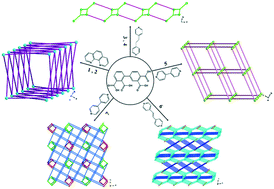Structural diversity and magnetic properties of Co(ii)/Mn(ii)/Ni(ii) coordination polymers constructed from an unsymmetrical tetracarboxylic acid and varying N-donor ligands†
Abstract
Seven new coordination polymers (CPs), namely, [M2(α-bptc)(phen)·2H2O]·3H2O (M = Co, for 1; Mn, for 2), [M2(α-bptc)(bpea)·7H2O]·H2O (M = Co, for 3; Ni, for 4), [Co3(α-Hbptc)2(4,4′-bipy)2·4H2O]·2H2O (5), [Co4(α-bptc)2(bpee)3·2H2O]·2H2O (6), and [Ni4(α-bptc)(4,4′-bipy)2(OH)4·4H2O]·13H2O (7) (α-H4bptc = 2,3,3′,4′-biphenyl tetracarboxylic acid, phen = 1,10-phenanthroline, bpea = 1,2-bis(4-pyridyl)ethane, 4,4′-bipy = 4,4′-bipyridine, bpee = 1,2-bis(4-pyridyl)ethylene), based on an unsymmetrical tetracarboxylic acid with the aid of varying ancillary N-donor ligands have been synthesized under hydrothermal conditions. Interestingly, the unsymmetrical tetracarboxylate linked Co(II)/Mn(II)/Ni(II) ions to give diverse structural fragments, which were connected by various ancillary N-donor ligands, resulting in the formation of CPs with different structural topologies. Complexes 1 and 2 were isomorphous and showed a 1D tube-like [M2(α-bptc)·2H2O] network decorated with phen moiety. Complexes 3 and 4 were also isomorphous and displayed a 1D ladder-like chain structure assembled by [M2(α-bptc)·7H2O] metallacycles as nodes and bpea as linkers. Complex 5 featured a 3D CdS net with 4-connected (65·8) topology constructed by the combination of 1D [Co3(α-Hbptc)2·3H2O] zigzag chain and 4,4′-bipy. Complex 6 exhibited a novel 3D framework with (4,4,6)-connected (42·42·6) topology formed through the integration of [Co2(α-bptc)·H2O] double layers with bpee. Complex 7 possessed a 3D bcu-x net with 4-connected (74·82) topology, yielded by linking the 4,4′-bipy with left- and right-handed [Ni4(α-bptc)(OH)4·4H2O] helical chains. Magnetic susceptibility measurements indicated the ferromagnetic behaviours of complex 7.



 Please wait while we load your content...
Please wait while we load your content...